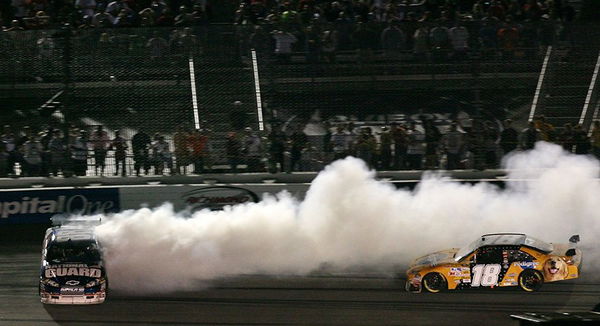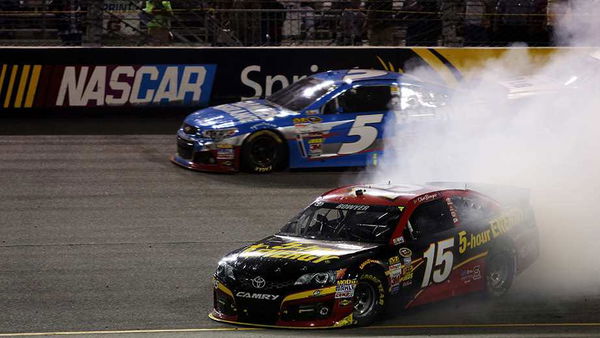
Getty
Photo by Jared C. Tilton/Getty Images

Getty
Photo by Jared C. Tilton/Getty Images
On a buzzing spring night in 2008, Richmond Raceway delivered one of its most unforgettable finales. In a tense overtime shootout with just a few laps to go, Kyle Busch bumped Dale Earnhardt Jr. in Turn 4, sending the beloved No. 88 spinning and clearing the path for Clint Bowyer to seize the win. That heated clash ignited a fierce rivalry and became the stuff of NASCAR legend, etched in the memories of fans as one of Richmond’s most dramatic showdowns.
Watch What’s Trending Now!
But that moment, just a single spark in a blaze of history, only scratches the surface of Richmond’s legacy. Since Lee Petty’s first NASCAR premier-series victory in April 1953, the ¾-mile oval has hosted eras of dominance, feuds, and headline-making finales. Let’s shift into reverse and relive the track’s defining chapters from its early kings to modern-day plot twists.
ADVERTISEMENT
Petty’s powerhouse era (1950s–1970s)
As NASCAR looks back at Richmond’s legacy, let’s see how it began with Lee Petty, who, on April 19, 1953, won the first NASCAR Grand National race at the fairgrounds planting the first flag in a long history of high-octane drama and deft craftsmanship. The track was still a half-mile dirt layout, far removed from the modern-day D-shaped asphalt oval, but the seeds of intensity were already planted.
As paving arrived and the track evolved, the next chapter belonged to Richard Petty, whose dominance was unmatched. From fall 1970 through spring 1973, he won seven consecutive NASCAR premier-series races at Richmond, contributing to a staggering career total of 13 victories at the track, numbers that still reverberate as a testament to his powerhouse career.
In those early decades, Richmond was rougher, more visceral, a track where sliding through corners, trusting mechanical grit over aerodynamic grip, rewarded those with precision and courage. And both Pettys personified that ethos.
ADVERTISEMENT
Rivalries & turning points (1980s–2000s)
The Brotherhood of rivals began with Kyle Petty’s first Cup Series win in 1986, a dramatic moment born from chaos when Darrell Waltrip and Dale Earnhardt Sr. collided with two laps remaining, handing the win to Petty and laying a blueprint for how rivalries could define Richmond.
ADVERTISEMENT
Fast forward to 1999, Tony Stewart, then a scratch rookie, made his unforgettable statement. Leading 333 of 400 laps, Stewart seized his first Cup victory at Richmond, launching a legendary career from the most impressive of all launchpads.
Then came May 3, 2008: the simmering tension between Kyle Busch and Dale Jr. erupted under bright lights. Their collision opened the door for Clint Bowyer to steal victory in a green-white-checkered finish, a win earned not by flawless execution but by opportunism in the chaos. And while Earnhardt didn’t point blame, fans booed Busch relentlessly as a rivalry had been forged.
The crowd’s reaction was instantaneous, boos rained down on Busch, Earnhardt later admitted the incident planted a seed of retaliation: “I felt like if I didn’t wreck you at some point, my fans were gonna be really pissed… I felt in my heart if I don’t get him back (in 2008), everybody’s going to look at me as this guy who gets wrecked and don’t do s—. It was just me being hard-headed and ignorant.”
ADVERTISEMENT

ADVERTISEMENT
The modern milestones (2010s–2020s)
By 2012, Richmond became the site of Kurt Busch’s triumph in the Xfinity Series a sweet victory for Kyle Busch’s own team, Kyle Busch Motorsports. Kurt edged Denny Hamlin by a mere 0.062 seconds, giving KBM its first win and proving that the Busch family legacy extends well beyond a single driver.
Few drivers have owned Richmond quite like Kyle Busch. By 2018, he joined an elite list by sweeping both Cup races in a single season. Across his career, Busch has racked up six Cup Series wins, 18 top-5s, and over 1,500 laps led at the three-quarter-mile oval statistics that cement his short-track mastery. Two years later, in 2013, Richmond hosted one of its most controversial finishes.
Clint Bowyer spun with seven laps remaining, triggering a caution that ultimately knocked Martin Truex Jr. out of the Chase lineup. NASCAR peeled back the curtain, revealing team orders and audio suggesting manipulation. The fallout was swift: $300,000 in fines, point penalties, and Truex left standing on the sidelines, bitterly cast aside.

Richmond is also where teammates collide. In April 2016, Carl Edwards and Kyle Busch, both Joe Gibbs Racing drivers, tangled on the final lap. Edwards executed a textbook bump-and-run, nudging Busch aside to win the Toyota Owners 400, and reminding us that even teammates can become rivals in the blink of a corner. But the track also set the stage for Martin Truex Jr.’s ultimate redemption.
Six years after being ousted from the 2013 playoffs at Richmond, Truex returned in 2019 to sweep both Cup events, breaking his long short-track drought and rewriting his personal narrative at the venue.
And most recently, in March 2024, on Easter Sunday, Richmond staged its first-ever Cup points race run on wet-weather tires. Despite Martin Truex Jr. leading 228 laps, it was home-town hero Denny Hamlin who pounced in overtime, thanks to a perfect pit stop to steal the Toyota Owners 400 in a dramatic two-lap shootout under damp skies.
Who’s racing toward Richmond after Watkins Glen?
William Byron enters Richmond in prime form, he’s now atop the regular-season NASCAR Cup Series standings, extending his lead to a comfortable 42-point advantage over teammate Chase Elliott thanks to a solid fourth-place finish at Watkins Glen, along with nine stage points.
Standing behind him, Denny Hamlin (with four wins) and Shane van Gisbergen (also four wins, including one at Watkins Glen) continue to drive confidently toward playoff eligibility. Meanwhile, Alex Bowman, Chris Buescher, and Tyler Reddick comfortably occupy the playoff bubble with healthy point buffers of +60, +34, and +117 respectively.
Looking deeper, Christopher Bell and Kyle Larson remain prime threats, each tied at 727 points with three wins apiece, both locked inside the top four of the standings. Ryan Blaney, consistent and smart, stays a strong contender cruising inside the top seven and bringing momentum from a solid Watkins Glen performance. These drivers are the ones to watch once the short-track fireworks ignite at Richmond.
Richmond Raceway has always been where rivalries ignite, redemption arcs unfold, and unforgettable moments are born. This year, the anticipation is electric. Fans are eager to see what new history will be written under the lights and which stories will echo through NASCAR for years to come.
ADVERTISEMENT
ADVERTISEMENT
ADVERTISEMENT

